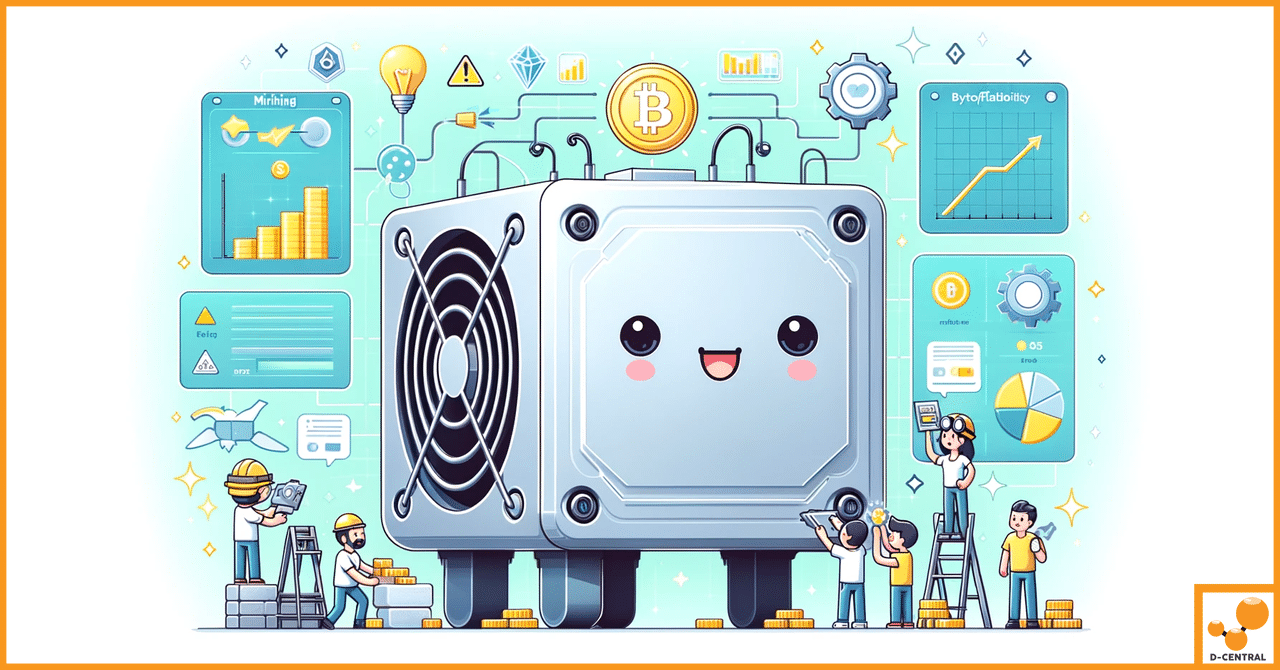
Why Does Bitcoin Have Value? Unraveling the Digital Gold’s Worth
What makes something valuable in an age where digital footprints are as significant as physical ones? In a world where
4479 Desserte Nord Autoroute 440, Laval, QC H7P 6E2

In the dynamic world of cryptocurrency mining, the Antminer S19 series stands out as a beacon of efficiency and power. Developed by Bitmain, one of the leading manufacturers in the mining hardware industry, the Antminer S19 series has been designed to offer unparalleled performance in the Bitcoin mining sector. This series includes several models, such as the Antminer S19, S19 Pro, S19j, and S19 XP, each tailored to meet the diverse needs of miners with varying levels of hash rates and energy efficiencies.
The significance of the Antminer S19 series in the Bitcoin mining industry cannot be overstated. As the demand for Bitcoin continues to grow, so does the complexity of mining it, necessitating the use of more powerful and efficient mining hardware. The Antminer S19 series rises to this challenge by providing miners with a robust solution capable of sustaining profitable operations even as the network’s difficulty increases. Its advanced technology and superior performance metrics make it a preferred choice for both individual miners and large-scale mining operations.
However, owning an Antminer S19 is only part of the equation for achieving success in the competitive landscape of Bitcoin mining. Optimizing mining operations becomes paramount to maximize profitability and ensure a favorable return on investment. This involves fine-tuning various aspects of the mining process, from selecting the right firmware and mining pool to implementing effective cooling systems and energy-saving strategies. By optimizing their Antminer S19 setups, miners can significantly enhance their efficiency, reduce operational costs, and increase their earnings in the long run.
In this context, understanding the tips and tricks for maximizing profitability with the Antminer S19 series is essential for anyone involved in Bitcoin mining. Whether you’re a seasoned miner looking to upgrade your operations or a newcomer eager to make your mark, this guide will provide you with the insights and strategies needed to optimize your mining setup and achieve optimal performance from your Antminer S19.
The Antminer S19 series represents the pinnacle of mining hardware technology, designed to tackle the increasing difficulty of Bitcoin mining. This series encompasses several models, each with distinct specifications that cater to various mining requirements and efficiency goals. Understanding the technical nuances of each model is crucial for miners who aim to optimize their operations for maximum profitability.
Antminer S19: The standard model in the series, the Antminer S19, boasts a hash rate of approximately 95 terahashes per second (TH/s) with a power consumption of around 3250 watts (W). It sets a solid baseline for efficiency and performance within the series.
Antminer S19 Pro: As the enhanced version of the standard model, the S19 Pro delivers a higher hash rate of around 110 TH/s, with power consumption also at about 3250W. This model offers a better hash rate to power consumption ratio, making it a more efficient choice for serious miners.
Antminer S19j: The S19j model provides a balance between the standard S19 and the Pro version, offering hash rates in the range of 90 to 100 TH/s and power efficiency slightly improved over the base model.
Antminer S19 XP: The most advanced model in the series, the S19 XP, pushes the boundaries with an impressive hash rate of 140 TH/s, while maintaining power efficiency with a consumption of around 3010W. This model represents the cutting edge in mining technology, offering the highest efficiency and lowest energy consumption per TH.
Performance: When it comes to raw performance, the Antminer S19 XP leads the pack with its superior hash rate, making it the most powerful option for miners looking to maximize their output. The S19 Pro follows closely, offering high performance with slightly lower energy demands than the XP. The standard S19 and S19j models provide robust performance for those seeking reliable mining capabilities without the premium cost of the higher-end models.
Power Efficiency: Efficiency is a critical factor in mining profitability, especially considering the high energy costs associated with continuous mining operations. The S19 XP stands out as the most energy-efficient model, boasting the lowest joules per terahash (J/TH) ratio, which translates to more mined Bitcoin per unit of electricity consumed. The S19 Pro also offers commendable efficiency, making it a preferred choice for miners focused on long-term sustainability.
Operational Costs: The initial acquisition cost of each model varies, with the S19 XP typically commanding the highest price due to its advanced capabilities. However, operational costs, primarily driven by electricity consumption, play a significant role in determining overall profitability. The S19 XP, despite its higher upfront cost, may offer lower operational costs over time due to its superior efficiency. Miners must consider their local electricity rates and the potential for future Bitcoin price fluctuations when evaluating the total cost of ownership for each model.
In summary, the Antminer S19 series offers a range of options to suit different mining strategies and budgets. The choice between models should be informed by a careful consideration of performance, efficiency, and operational costs, aligned with the miner’s specific goals and the prevailing conditions of the Bitcoin network and market.
Setting up your Antminer S19 for the first time is a critical step that lays the foundation for efficient and profitable mining operations. Proper setup and configuration not only ensure optimal performance but also help in avoiding common pitfalls that could lead to downtime or reduced mining efficiency. Here are the best practices for setting up your Antminer S19 and understanding its interface for effective configuration.
By following these best practices for the initial setup and configuration of your Antminer S19, you can ensure a smooth start to your mining operations, paving the way for efficient and profitable mining activity. Regular monitoring and adjustments based on performance data will help in maintaining optimal mining efficiency over time.
Optimizing your Antminer S19 operations is crucial for maximizing profitability and ensuring long-term sustainability. This involves not just the initial setup but also ongoing adjustments and improvements, particularly in areas such as firmware upgrades, cooling solutions, and energy efficiency.
Upgrading the firmware of your Antminer S19 can significantly enhance its performance and efficiency. Custom firmware options like BraiinsOS, LuxOS, and VNish offer tailored solutions that go beyond the capabilities of the stock firmware provided by the manufacturer.
BraiinsOS: Developed by Braiins, BraiinsOS is an open-source firmware designed to improve the efficiency and flexibility of Bitcoin mining operations. It features autotuning capabilities, which dynamically adjust the performance of each chip to its optimal efficiency point, potentially increasing hash rate and reducing power consumption.
LuxOS: Offered by Luxor Technologies, LuxOS firmware is engineered to supercharge your ASIC miner’s hashrate while maintaining power efficiency. It includes advanced tuning profiles that allow for granular control over mining operations, unlocking custom pool fees and optimizing performance based on current network conditions.
VNish: VNish firmware is focused on providing professional solutions for overclocking Antminer devices, including the S19 series. It aims to increase the profitability of equipment by enhancing hash rate capabilities and offering features for detailed monitoring and management of mining operations.
Benefits of Using Custom Firmware:
Maintaining optimal temperatures is vital for the longevity and efficiency of your Antminer S19. Excessive heat can lead to hardware damage, reduced lifespan, and decreased mining efficiency.
Tips for Setting Up Efficient Cooling Systems:
Reducing power consumption is key to improving the profitability of your mining operations, especially as electricity costs can constitute a significant portion of operational expenses.
Strategies for Reducing Power Consumption:
Integrating Renewable Energy Sources:
By focusing on these key areas—firmware upgrades, cooling solutions, and energy efficiency—you can optimize your Antminer S19 operations for enhanced performance, reduced costs, and increased profitability. Regular monitoring and adjustments based on performance data and changing network conditions will help maintain optimal mining efficiency.
To further enhance the performance and profitability of Antminer S19 operations, miners can employ advanced optimization techniques. These methods involve fine-tuning the hardware beyond standard configurations, leveraging the capabilities of custom firmware, and strategically managing operational parameters.
Overclocking involves pushing your Antminer S19 beyond its default operational parameters to increase its hash rate and, consequently, its mining output. This technique can lead to significant gains in profitability but comes with inherent risks:
Underclocking, on the other hand, involves reducing the operational intensity of the Antminer S19. This technique can be particularly useful in scenarios where energy efficiency is prioritized over maximum output:
BraiinsOS introduces autotuning, a dynamic optimization feature that adjusts the performance of each individual mining chip to its most efficient operating point. This process involves:
LuxOS offers a unique advantage by allowing miners to unlock custom pool fees when using Luxor’s mining pool. This feature can have a direct impact on profitability:
VNish firmware is tailored for miners seeking to maximize their hash rate without compromising the stability of their Antminer S19. Key features include:
By employing these advanced optimization techniques, miners can significantly enhance the performance and profitability of their Antminer S19 units. However, it’s crucial to approach these methods with caution, considering the potential risks and ensuring that any modifications are made within the bounds of hardware capabilities and cooling constraints.
For many miners, especially those operating on a smaller scale like individual Antminer S19 owners, joining a mining pool is a strategic decision that can significantly influence profitability. A mining pool allows individual miners to combine their hashing power with others, increasing their chances of solving a block and earning Bitcoin rewards. However, not all mining pools are created equal, and choosing the right one requires careful consideration of several key factors.
Choosing the right mining pool is a critical decision that can directly affect the bottom line of your mining operation. The right pool can enhance your earnings by offering lower fees, fair payout schemes, and consistent rewards. Conversely, joining a pool that isn’t well-suited to your needs or has unfavorable terms can significantly diminish your profitability.
For Antminer S19 owners, the pool’s ability to support the high hash rate and efficiency of the device is also crucial. The pool should be capable of effectively managing the contributions of such powerful miners and distributing rewards in a way that reflects the miner’s performance.
In summary, selecting the appropriate mining pool requires a careful analysis of various factors, including fees, payout schemes, pool size, server location, security, and community support. By choosing wisely, you can optimize the profitability of your Antminer S19 and ensure a more stable and rewarding mining experience.
To ensure the sustained performance and longevity of your Antminer S19, regular hardware checks and maintenance are indispensable. Just like any high-performance computing equipment, mining hardware is subject to wear and tear, and its operational efficiency can degrade over time if not properly maintained. Moreover, consistent monitoring allows you to quickly identify and address any issues that could lead to downtime or reduced mining efficiency.
Monitoring Tools:
Maintenance Practices:
By incorporating routine maintenance and monitoring into your mining operations, you can ensure that your Antminer S19 continues to operate at peak efficiency, maximizing your mining profitability and safeguarding your investment in the long term.
Effective cost management is crucial for maximizing the profitability of your Antminer S19 mining operations. Understanding and managing the various components of operational costs can significantly impact your return on investment (ROI). Here’s how to break down these costs and calculate your ROI, along with strategies to enhance it.
ROI is a measure of the profitability of your investment, calculated by comparing the net returns to the initial costs. For your Antminer S19, the ROI calculation involves:
By carefully managing operational costs and employing strategies to enhance efficiency and extend hardware lifespan, you can improve the ROI of your Antminer S19 and ensure a more profitable and sustainable mining operation.
Maximizing the profitability of your Antminer S19 involves a multifaceted approach that extends beyond merely powering on the device and connecting it to a mining pool. The strategies outlined in this guide—from optimizing hardware settings and firmware, to efficient cooling and energy management, to navigating the legal and regulatory landscape—highlight the complexity and dynamism of cryptocurrency mining. Each element plays a crucial role in ensuring that your mining operations are not only profitable but sustainable in the long run.
The cryptocurrency mining landscape is continually evolving, with frequent changes in network difficulty, Bitcoin price fluctuations, and advancements in mining technology. Staying informed about these changes and being willing to adapt your strategies accordingly is essential for maintaining a competitive edge.
To further enhance your knowledge and optimization strategies, we encourage you to explore additional resources and tools dedicated to Bitcoin mining. Online forums, mining blogs, and industry publications can provide valuable insights and updates on the latest trends and technologies in cryptocurrency mining.
Engaging with a community of fellow miners can also be incredibly beneficial. Mining communities are a great source of shared knowledge, experiences, and troubleshooting tips. Participating in discussions, asking questions, and sharing your own experiences can help you and others overcome common challenges and discover new optimization techniques.
In conclusion, maximizing the profitability of your Antminer S19 requires a combination of technical optimization, cost management, legal compliance, and continuous learning. By embracing these strategies and remaining engaged with the mining community, you can navigate the complexities of cryptocurrency mining and achieve long-term success. Remember, the most successful miners are those who are adaptable, informed, and proactive in optimizing their operations.
What is the Antminer S19 series?
The Antminer S19 series includes several models of Bitcoin mining hardware developed by Bitmain, designed to offer high performance and efficiency for cryptocurrency mining. The series includes models like the Antminer S19, S19 Pro, S19j, and S19 XP, catering to different levels of mining requirements.
Why is optimizing mining operations important for the Antminer S19?
Optimizing mining operations is crucial for maximizing profitability and ensuring a favorable return on investment. It involves fine-tuning various aspects of the mining process, including firmware and mining pool selection, cooling systems, and energy-saving strategies to enhance efficiency, reduce operational costs, and increase earnings.
What are the key differences between the models in the Antminer S19 series?
Key differences include hash rates, power consumption, and efficiency. For example, the Antminer S19 XP boasts a hash rate of 140 TH/s with power consumption around 3010W, making it highly efficient, while the standard Antminer S19 offers a hash rate of approximately 95 TH/s with around 3250W of power consumption.
How can the profitability of Antminer S19 operations be enhanced?
Profitability can be enhanced by upgrading firmware to custom options for increased efficiency, implementing effective cooling solutions to maintain optimal temperatures, managing energy consumption strategically, and selecting the right mining pool based on fees, payout schemes, and server location.
What are the benefits of using custom firmware on the Antminer S19?
Custom firmware can unlock higher hash rates, provide better power efficiency, enhance stability, and offer advanced features for monitoring and management. Options like BraiinsOS, LuxOS, and VNish offer tailored solutions for optimizing mining performance.
Why is selecting the right mining pool critical for Antminer S19 owners?
Choosing the right mining pool is essential because it directly affects profitability. Factors to consider include fees, payout schemes, pool size, server location, and security. A suitable mining pool maximizes earnings by offering favorable terms and reliable payouts.
How should routine maintenance and monitoring of the Antminer S19 be conducted?
Routine maintenance should include regular cleaning, applying fresh thermal paste, inspecting and replacing cooling fans as necessary, and updating firmware. Monitoring tools like the built-in web interface, mining pool dashboards, and third-party software can help track performance and address issues promptly.
What strategies can improve the Return on Investment (ROI) for Antminer S19 operations?
Improving ROI involves optimizing energy usage, enhancing mining efficiency through firmware updates and cooling, managing hardware lifespan via regular maintenance, and staying informed about market conditions to adjust operations accordingly.
DISCLAIMER: D-Central Technologies and its associated content, including this blog, do not serve as financial advisors or official investment advisors. The insights and opinions shared here or by any guests featured in our content are provided purely for informational and educational purposes. Such communications should not be interpreted as financial, investment, legal, tax, or any form of specific advice. We are committed to advancing the knowledge and understanding of Bitcoin and its potential impact on society. However, we urge our community to proceed with caution and informed judgment in all related endeavors.
Related Posts

What makes something valuable in an age where digital footprints are as significant as physical ones? In a world where

Bitcoin, the first and most well-known cryptocurrency, has revolutionized the financial landscape since its inception in 2009. At its core,

As winter approaches, the quest for efficient heating solutions becomes crucial, especially for cryptocurrency enthusiasts. D-Central’s innovative crypto mining space